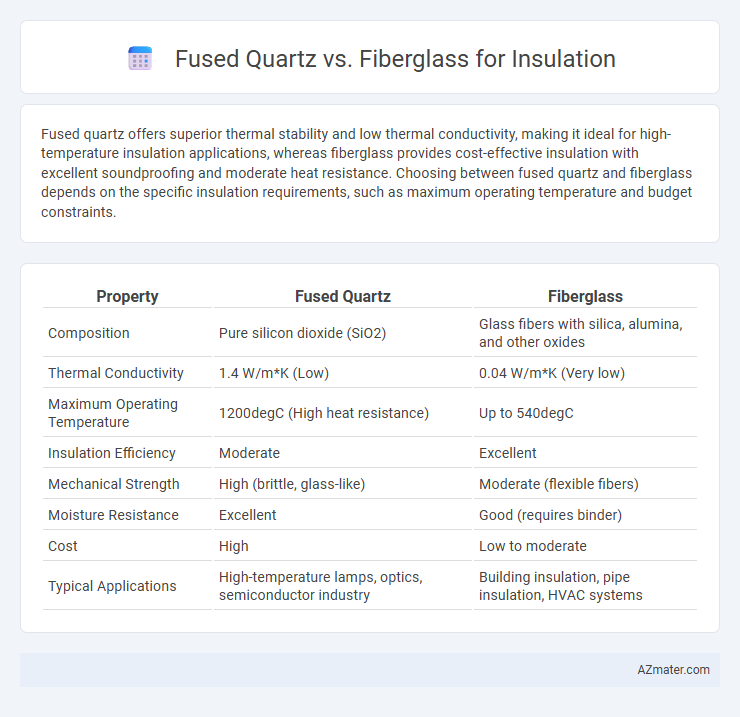Fused quartz offers superior thermal stability and low thermal conductivity, making it ideal for high-temperature insulation applications, whereas fiberglass provides cost-effective insulation with excellent soundproofing and moderate heat resistance. Choosing between fused quartz and fiberglass depends on the specific insulation requirements, such as maximum operating temperature and budget constraints.
Table of Comparison
| Property | Fused Quartz | Fiberglass |
|---|---|---|
| Composition | Pure silicon dioxide (SiO2) | Glass fibers with silica, alumina, and other oxides |
| Thermal Conductivity | 1.4 W/m*K (Low) | 0.04 W/m*K (Very low) |
| Maximum Operating Temperature | 1200degC (High heat resistance) | Up to 540degC |
| Insulation Efficiency | Moderate | Excellent |
| Mechanical Strength | High (brittle, glass-like) | Moderate (flexible fibers) |
| Moisture Resistance | Excellent | Good (requires binder) |
| Cost | High | Low to moderate |
| Typical Applications | High-temperature lamps, optics, semiconductor industry | Building insulation, pipe insulation, HVAC systems |
Introduction to Fused Quartz and Fiberglass Insulation
Fused quartz insulation offers exceptional thermal resistance and stability due to its high purity silicon dioxide composition, making it ideal for high-temperature applications. Fiberglass insulation consists of fine glass fibers that trap air, providing excellent thermal and acoustic insulation commonly used in residential and commercial buildings. Both materials serve distinct purposes in insulation, with fused quartz excelling in extreme heat scenarios and fiberglass offering cost-effective, versatile thermal management.
Material Composition and Structure
Fused quartz insulation is composed of high-purity silicon dioxide with an amorphous, non-crystalline structure that offers exceptional thermal stability and low thermal expansion, making it ideal for high-temperature applications. Fiberglass insulation consists of fine glass fibers, typically made from recycled glass and sand, arranged in a porous, fibrous mat that effectively traps air for superior thermal resistance and sound absorption. The solid, compact nature of fused quartz contrasts with the lightweight, flexible, and airy structure of fiberglass, influencing their suitability for different insulation needs.
Thermal Insulation Performance
Fused quartz exhibits superior thermal insulation performance due to its extremely low thermal conductivity, around 1.4 W/m*K, making it highly effective in high-temperature environments up to 1100degC. Fiberglass insulation, with thermal conductivity typically between 0.035 and 0.045 W/m*K, excels at reducing heat transfer in residential and commercial applications but degrades under prolonged exposure to temperatures exceeding 250degC. The superior thermal stability and minimal thermal expansion of fused quartz provide enhanced insulation efficiency in industrial settings requiring resistance to thermal shock and high heat.
Mechanical Strength and Durability
Fused quartz exhibits superior mechanical strength and long-term durability due to its high resistance to thermal shock and chemical corrosion, making it ideal for extreme environments. Fiberglass offers good mechanical strength but tends to degrade faster under prolonged exposure to moisture and UV radiation, leading to reduced insulation performance. The choice between fused quartz and fiberglass depends on the specific application requirements for thermal stability and structural integrity over time.
Resistance to Moisture and Chemical Corrosion
Fused quartz exhibits exceptional resistance to moisture and chemical corrosion due to its pure silica composition, making it ideal for environments with high humidity and aggressive chemicals. Fiberglass insulation, while effective in thermal performance, is more susceptible to moisture absorption, which can degrade its insulating properties and promote mold growth. Chemical resistance in fiberglass is limited compared to fused quartz, which maintains structural integrity and insulation performance under exposure to acids, alkalis, and solvents.
Temperature Tolerance and Fire Resistance
Fused quartz offers exceptional temperature tolerance, maintaining stability up to 1,650degC (3,002degF), far surpassing fiberglass, which typically withstands temperatures up to 540degC (1,000degF). In terms of fire resistance, fused quartz is non-combustible and does not release toxic fumes, making it ideal for high-risk fire environments, while fiberglass, although flame resistant, can melt and release irritant fibers under extreme heat. This superior thermal performance and fire safety make fused quartz the preferred material for insulation in applications requiring maximum heat endurance and fire protection.
Environmental Impact and Sustainability
Fused quartz demonstrates superior environmental sustainability due to its high durability, recyclability, and low thermal expansion, which reduces energy consumption in insulation applications. Fiberglass insulation, while widely used and cost-effective, involves energy-intensive manufacturing and contains materials that are less recyclable, leading to greater environmental impact over its lifecycle. Choosing fused quartz insulation supports long-term sustainability efforts by minimizing resource depletion and reducing waste generation compared to conventional fiberglass alternatives.
Installation Methods and Versatility
Fused quartz insulation offers superior thermal stability and is often installed in high-temperature industrial applications using specialized adhesives or mechanical fasteners to maintain integrity under extreme conditions. Fiberglass insulation, favored for residential and commercial buildings, is typically installed with staples, friction fit, or in batts and rolls, allowing flexible application in walls, attics, and HVAC systems. The versatility of fiberglass makes it suitable for diverse environments, whereas fused quartz excels in niche high-temperature insulation requiring precision installation techniques.
Cost Comparison and Economic Considerations
Fused quartz insulation generally incurs higher upfront costs compared to fiberglass due to its superior thermal stability and durability, making it ideal for high-temperature applications. Fiberglass is more economical for general insulation needs, offering a lower initial investment and widespread availability, which makes it cost-effective for large-scale projects. Economic considerations should include lifecycle expenses, as fused quartz's longer lifespan and resistance to degradation may reduce replacement frequency, ultimately offsetting its higher initial price.
Application Suitability: Choosing the Right Insulation
Fused quartz offers exceptional thermal stability and low thermal expansion, making it ideal for high-temperature industrial applications and scientific equipment. Fiberglass insulation excels in residential and commercial building use due to its cost-effectiveness, good thermal resistance (R-value), and ease of installation. Selecting insulation depends on specific application needs: fused quartz is preferred for extreme heat environments, while fiberglass suits standard thermal insulation requirements.

Infographic: Fused quartz vs Fiberglass for Insulation
 azmater.com
azmater.com